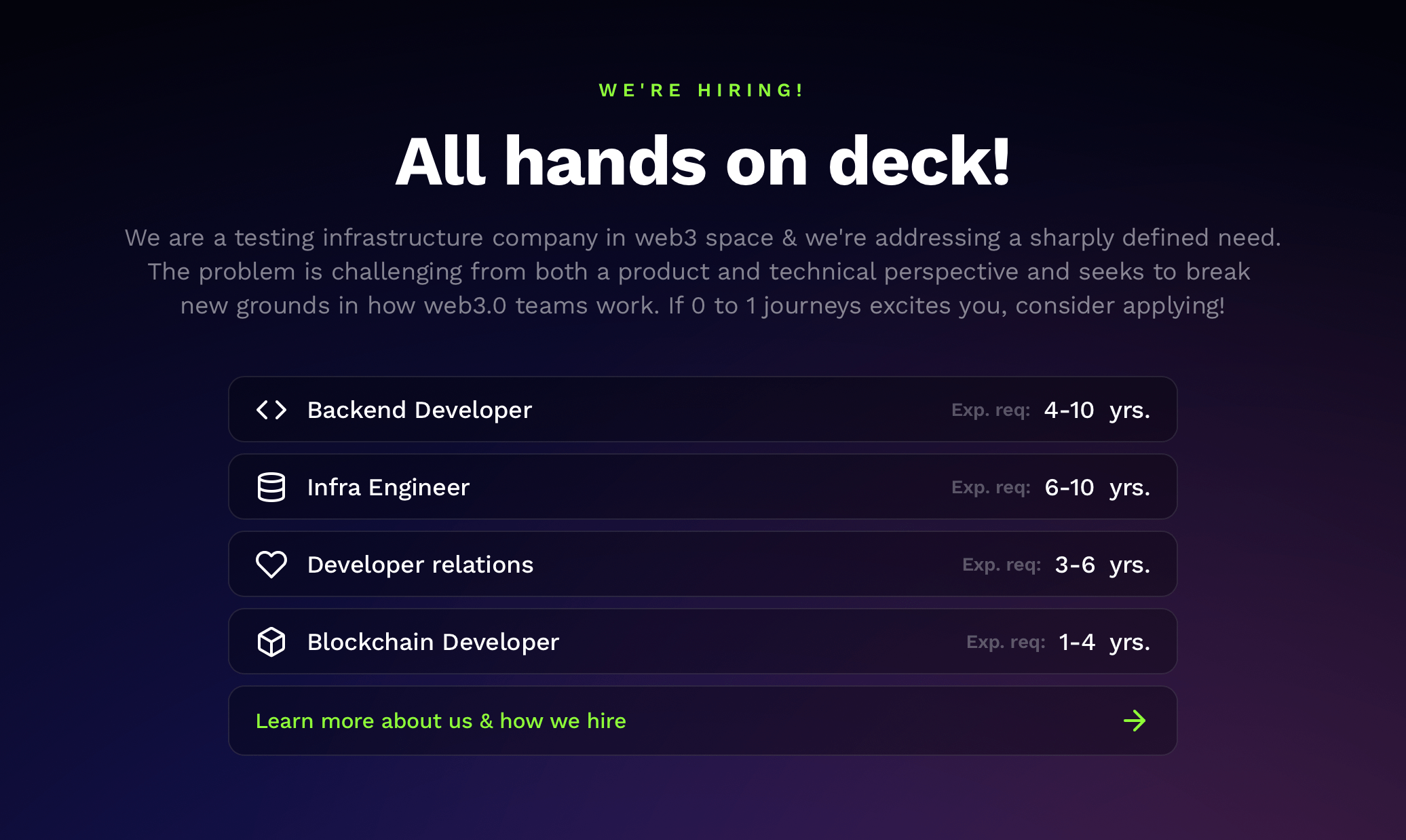7 July 2022
New design job
After 6+ months of personal sabbatical, I’m joining Harbor as Founding Lead Designer

TL;DR:
I am a Digital Product Designer and have been designing professionally for over 10+ years. Last year in November 2021, I took a 6-month personal sabbatical before starting to look for my next design role.
Fast forward to 6+ months of my sabbatical and a few weeks of job hunting in May this year, I found the best fit for myself at Harbor and joining them as Founding Lead Designer starting July 2022.
A brief history of my design career so far
College days
I, like most Indian teenagers, opted for engineering in college. But I didn’t opt for just any major. I was very much into cars back then (I still am). So I chose Automotive Engineering as my major.

But soon after my 1st year of college, I realized that most of the things that were being taught there, were just theory and the curriculum wasn’t designed to gain real world experiences. Plus, each semester, I kept failing in more papers. So for the remaining time of my college, I didn’t study much and spent most of my time playing football and figuring out 2D & 3D design tools - At the end of the 4th year, I had 15+ backlogs to clear but a decent design portfolio.
1st job
Because of a design portfolio and a few of my work being published in national & international media, I landed a gig with a startup in my last semester of college, with the responsibility of designing their B2C healthcare app. While I enjoyed designing the product, the startup seemed to lack focus and a bias towards action. So I knew I had to secure myself a better job before my college ends.
 1st startup job - designing their B2C healthcare app
1st startup job - designing their B2C healthcare app
2nd job
Meanwhile, one of my best friend got placed in an advertising company (VDX.tv) and had told me good things about the company culture. So I prototyped my way into this job as a UI designer with a decent pay - courtesy of a re-branding project I did for the company and my design portfolio that I emailed directly to the CEO.
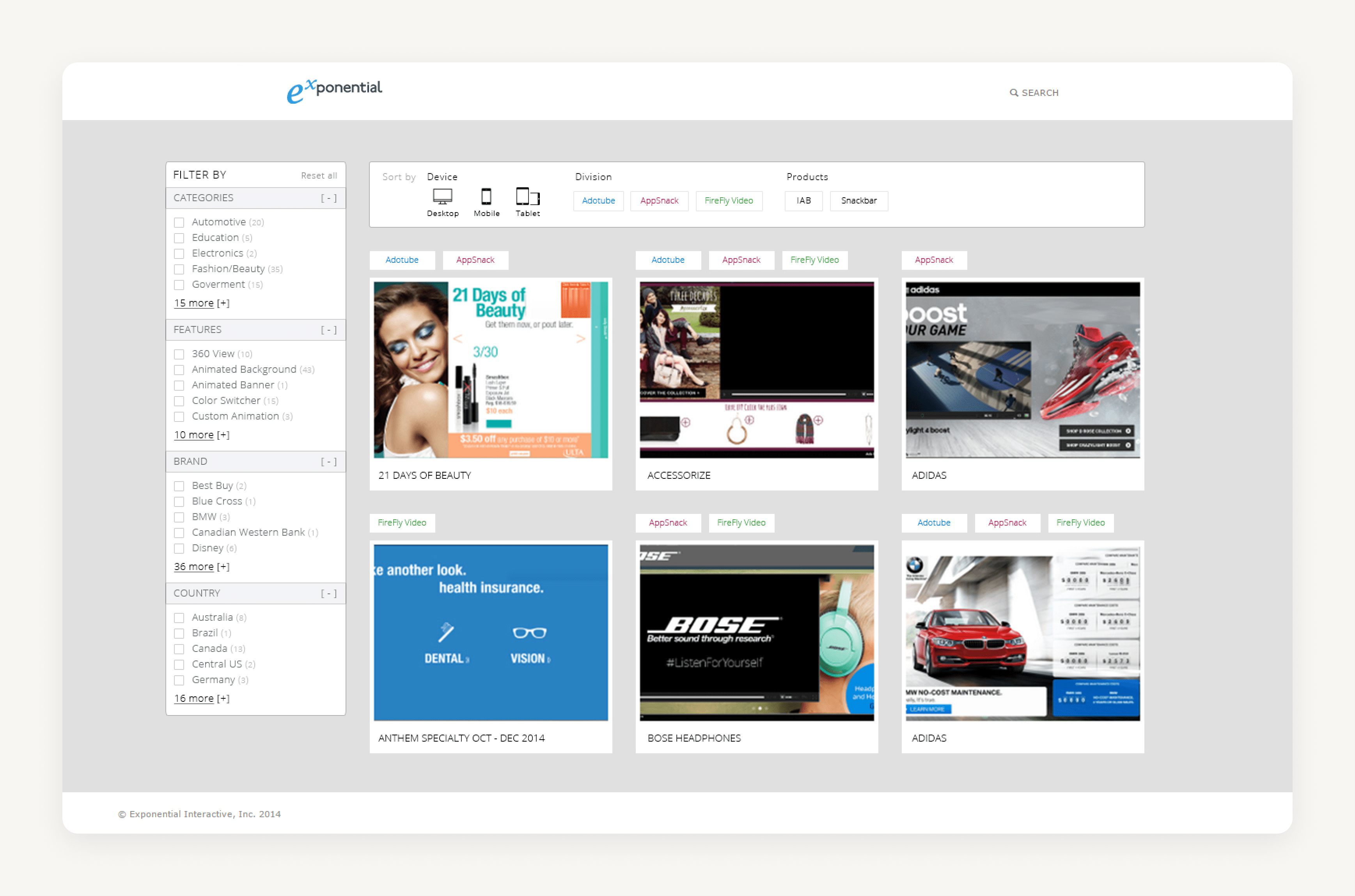 Some UI work I did at VDX.tv (called Exponential previously)
Some UI work I did at VDX.tv (called Exponential previously)
I worked there for a year and realized that there was not much room for me there to grow as a Product Designer because the company was designed to serve advertising clients primarily. It wasn’t a typical product company that I had hoped for. Although the company had a splendid creative team, designing ads for clients all over the world - it wasn’t something that I wanted to do. So I decided to move on.
3rd job
I started interviewing with a few companies and luckily, Wingify, a bootstrapped & very well known Indian company who makes VWO.com clicked. I joined them as a Product Designer.
 VWO’s mobile AB testing feature that I worked during my 1st year
VWO’s mobile AB testing feature that I worked during my 1st year
At Wingify, I worked on their flagship product for about a year and later moved to their Labs division - created to experiment with new B2B & B2C ideas. It was an amazing time for me at Wingify Labs as I was truly building 0 → 1 products. Over the next 2 years, I worked on 8 different projects, ranging from a product to discover books (similar to GoodReads), a marketplace for luxury boutiques & designers, a subscription-based news product, a few more SaaS ideas, and also a hardware project to digitally frame your pictures.
4th job
My experience with building multiple 0 → 1 products at Wingify Labs and a new found love towards it, led me to join a very small but fully distributed company called SellerCrowd in 2018.
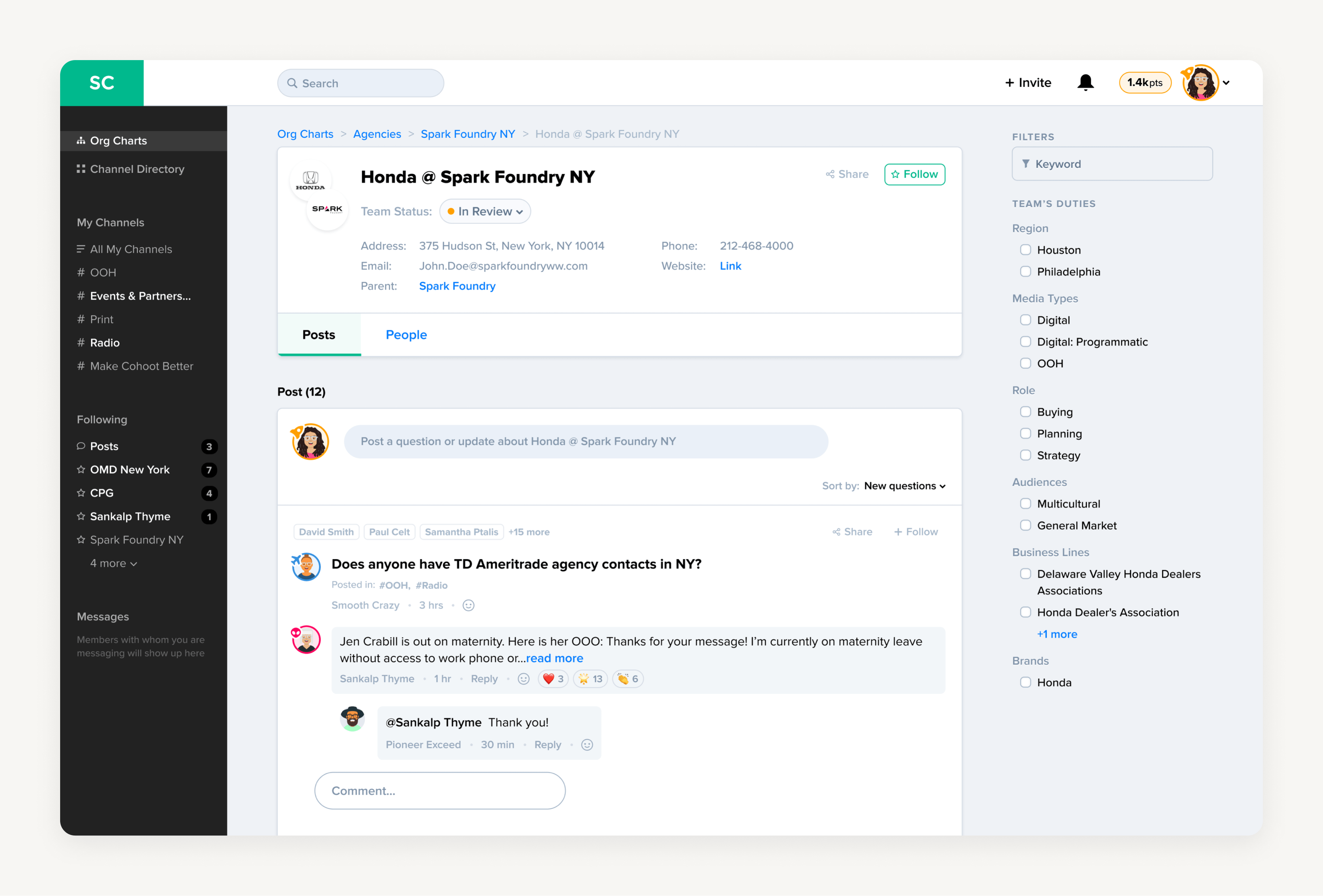 Glimpse of SellerCrowd’s OrgChart that I helped the company redesign among all the other features
Glimpse of SellerCrowd’s OrgChart that I helped the company redesign among all the other features
SellerCrowd was a SaaS tool that helped sellers in the advertising industry find industry insights via a Q&A-based feed (kind of like Quora). During my time at SellerCrowd, I helped the company redesign the product from scratch, setting up & scaling their design system, talking to users, writing product requirements in collaboration with PMs, ensuring pixel-perfect implementation in collaboration with devs and QAs. The team was lean. People were friendly and very collaborative. We had multiple get-togethers in various locations in Europe/Asia. We laughed with each other but also challenged each other at work. I loved my time there and feel grateful for the opportunity.
 SellerCrowd’s team photo from our offsite in Lisbon in 2018
SellerCrowd’s team photo from our offsite in Lisbon in 2018
After working for about 4 years at SellerCrowd, I felt I had done justice to the role that I was hired for. The product was out of 0 → 1 design phase and demanded more maintenance work & tweaking. It was then that I decided to move on and find another 0 → 1 journey to be a part of.
The sabbatical
The idea of mini-retirements was always on my mind, especially after reading the book “The 4-hour Work Week” during my college days. So when I decided to leave SellerCrowd, I took a pause and contemplated on whether to start job hunting immediately or take that break I’ve always been dreaming about.
After discussing my plans with my wife, carefully assessing my finances to make sure I had a proper runway, I decided to take the leap of faith and go on my first ever personal sabbatical for 6 months. The rationale I had in my mind was simple: “I’ve worked straight for 10 years, I deserve to take 6 months off.”
 Picture of me working on side projects and enjoying my sabbatical in mountains of north India
Picture of me working on side projects and enjoying my sabbatical in mountains of north India
The goal of my sabbatical was simple. Take rest. Don’t think about work. Let new ideas come naturally for new side projects. And work on my personal website which also acts as my portfolio - so it’s ready when I start my job hunt after 6 months.
You can read more about the Why, How, and What of my sabbatical in this detailed writeup but here’s a summary of what I did in the last 6 months:
- Designed & coded my personal website - Sankalpsinha.com
- Started a side project called BuildwithFramer.com - Helping creators launch their next site within hours using pre-built and fully-responsive templates
- Started another side project called visit.page - Helping creators build a better link-in-bio page
- Started going to gym thrice a week
- Became regular in playing football again
Entering job hunt phase
Throughout my sabbatical, I kept my personal website as my priority vs. side projects because I knew I had to go back to a full-time job. By the end of 6 months, I was comfortable to start applying to companies and chat about my new role.
Strategically, I was also building my personal site in public i.e. I was sharing updates of my work progress on my socials - that attracted a lot of potential employers to my DMs. They reached out explicitly mentioning how they liked my website and my work, and that they’d like to chat with me about a potential design role.

My biggest advice here to people starting to look out for a change:
Never underestimate putting your work out. You never know who might come across your work on the internet.
What kind of companies I wanted to work with?
I was chatting with most companies / founders reaching out to me because I wanted to stay in “explore” mode for a couple of weeks before narrowing down on the type of companies. But even then, I was very clear on which type of companies / founders I wanted to work with. Few of the core characteristics that I was looking for were:
- 0 → 1 journey - A product that’s just getting started or a product that’s yet to find a product-market fit. Although 0 to 1 product was my first preference, it wasn’t the deal breaker. The essence I am after is an entrepreneurial culture within a team or company - which usually is seen in startups more but a few bigger orgs can also adopt it successfully. So I was open in this regard.
- Lead designer role - I love owning the whole product design lifecycle. I have been doing this for a few years now, for both my day jobs and for all my side projects. This includes, leading projects with both macro & micro plan, laying out tasks clearly, communicating progress with team members effectively, resolving conflicts to ship faster, etc. I thrive in ambiguity and don’t like micro-management - and this one requirement was key for me and was a deal breaker.
- Lean team - A company with no more than 50 employees. Companies with employee size larger than 50 start to inject a ton of processes for almost everything at work and that kills the startup vibe and the ability to get things done faster in nearly every department.
- Product & market clarity in founders - Working with founders who’ve shipped software before, who know the market they are serving, and are customer centric, goes a long way. This ensures that the team can focus on the right business & user problems vs. working on the wrong ones due to lack of product / business fundamentals.
- Incremental progress over perfection: I love shipping software with great reverence for design. But what I dislike more is to not ship something for weeks and spending time in perfecting - only to find later that the thing we made, doesn’t serve users as intended. This is why I want to strike a balance between shipping something that’s good from a design standard but also shipping fast to validate assumptions. I want to work with people who have bias towards action and who don’t shy away from shipping things out in the world fast to figure stuff out.
Company culture is important too
Apart from the product and the company, it’s also important for me to work with kind & humble people. I’d take kindness & humility any given day vs. smart but cocky team members. So, alongside the core characteristics I mentioned above, there were a few values around culture that I used to filter companies. I even ended up making a slide for me and employer’s clarity:
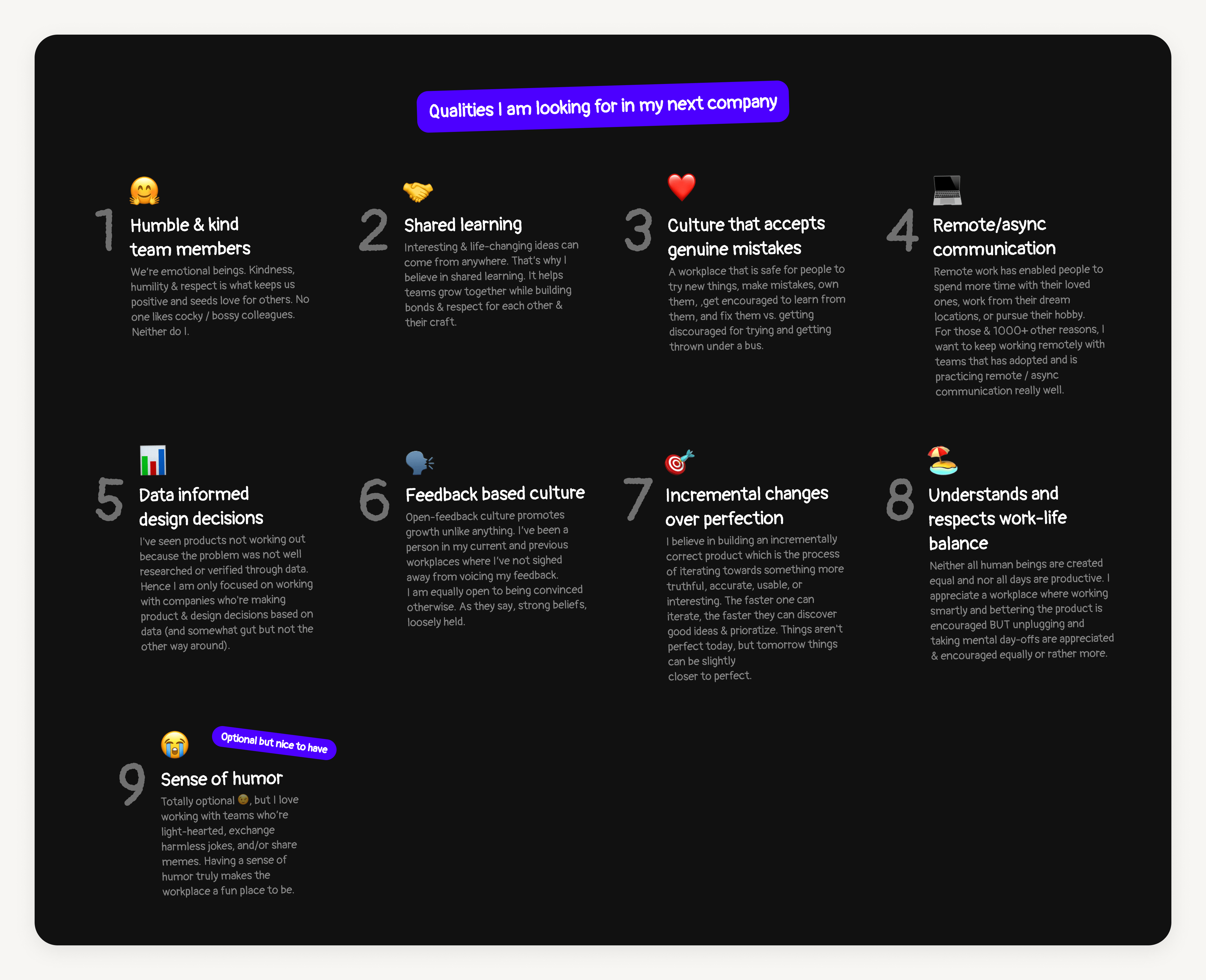 Slide I made for me and employer’s clarity
Slide I made for me and employer’s clarity
No industry preference is the best preference you can have as a designer.
Another important preference that I always had while job hunting was to not limit myself to any specific industry. Like I know a ton of designers who only want to work in fintech, food-tech, transportation, etc.
Why I haven’t made that distinction for myself is for a simple reason: I am a builder & problem solver first. Think of me as a plumber. Now, if I restrict myself to only fix taps of specific kind, I am only limiting my ability to gain experience in fixing taps of all kinds. And that’s why I want to keep my industry type preference “open”. This allows me to be open to new industries and go there with the intention solving problems and not playing favorites towards a specific industry.
What was the design interview process like?
The interview rounds in most companies that I talked to consisted of 3-4 rounds.
-
Intro call: A basic meet & greet call where both parties casually chat about the role, what they're looking for from each other, and gauge whether there's a mutual fit. This call usually lasts for about 30-60 mins.
Note: At this stage I'd discuss compensation with the founders to avoid spending a lot of time in interview rounds and finding that the company doesn't have the budget to hire me. I always suggest to talk commercials right in the intro call if you're not in a rush to close a job.
-
Design portfolio walkthrough: If we both feel there’s a mutual fit, in this round I’d present my past design work to a few team members. The call will most definitely consist of a hiring manager, founder(s) if they’re interested, and a few team members. During the presentation, I give them a walkthrough of my design process and 1 or 2 case studies. The call is supposed to demonstrate my design skills to the team & my employer.
Things they usually look for are:
- Communication skills: Can Sankalp communicate problems & solutions in a nice & concise way?
- Design thinking skills: Is Sankalp asking the right questions about the problem? How does he approach critical thinking?
- Team collaboration & feedback: Who did Sankalp collaborate with on the project and how did he work with them? How did Sankalp react to feedback or provide feedback to team members?
- Ownership mindset or requires micro-management: Can Sankalp own projects as Lead Product Designer and see them through completion or will he require micro management from leaders / team members to figure things out.
- UI / execution skills: Once Sankalp has identified problems and has a plan to execute, how does he execute the project? What does his final hi-fi mockup looks like? How does he do dev handoff?
-
Team call: If all goes well and I am able to convince the team or the founder(s) that I can execute ideas with no hand holding, there’s usually a round with other team members. Here, again, both the parties are trying to gauge how they both would feel working with each other on a daily basis. There can be some repeat questions from round 1 & 2 but it’s for everyone’s benefit.
Since both of them will spend a good amount of time working with each other, liking each other is as a human being is very important.
-
Final round with founders: If both parties give a go ahead from the team call round, there’ll be a final round with the founder(s). This is mostly to just discuss compensation and other details of contract.
Hope for the best, prepare for the worst
Almost all the companies that I talked to during my job hunt had all these rounds in place. Some skipped the 3rd round i.e. team round as they’d be present in design portfolio round and didn’t feel the need to introduce more members to gauge. But worth highlighting that I was quite comfortable in all these rounds. A few key reasons were:
-
My confidence in my personal website - People who were interviewing me were already impressed by my work on my personal site and side projects.
-
My intro call presentation - I had prepared a 10-min presentation for all intro calls where I used to walk the founder(s) through my previous work, my side projects, what my responsibilities were at my previous job, what made me a designer, why I choose to do it everyday, my design process, and also a few fun personal details about me so they knew that they’re hiring a human being that they’ll enjoy working with.
Almost every person that I gave this presentation to, applauded me on the presentation with a common remark of “I’ve never seen anyone do such a nice presentation about themselves as a designer”.
-
My ability to communicate clearly + having a sense humour - I’ve always been a person who speaks his mind. That means saying what I feel is right and also cracking jokes for the comic person I am. A lot of interviewers gave me the feedback that they liked my directness and that I was fun to chat with.
I think showing up as who you are and speaking your mind in interviews is very underrated and I hear people fail miserably to land a job because they’re trying to be someone that they’re not. You can’t fake your way into a company. Good founders are great interviewers and can catch when you’re faking it.
After spending about 4-5 effective weeks and chatting with about 12 companies around the world, I decided to join a super early-stage startup called Harbor (Now p0.inc).
Meet Harbor (Now p0.inc)
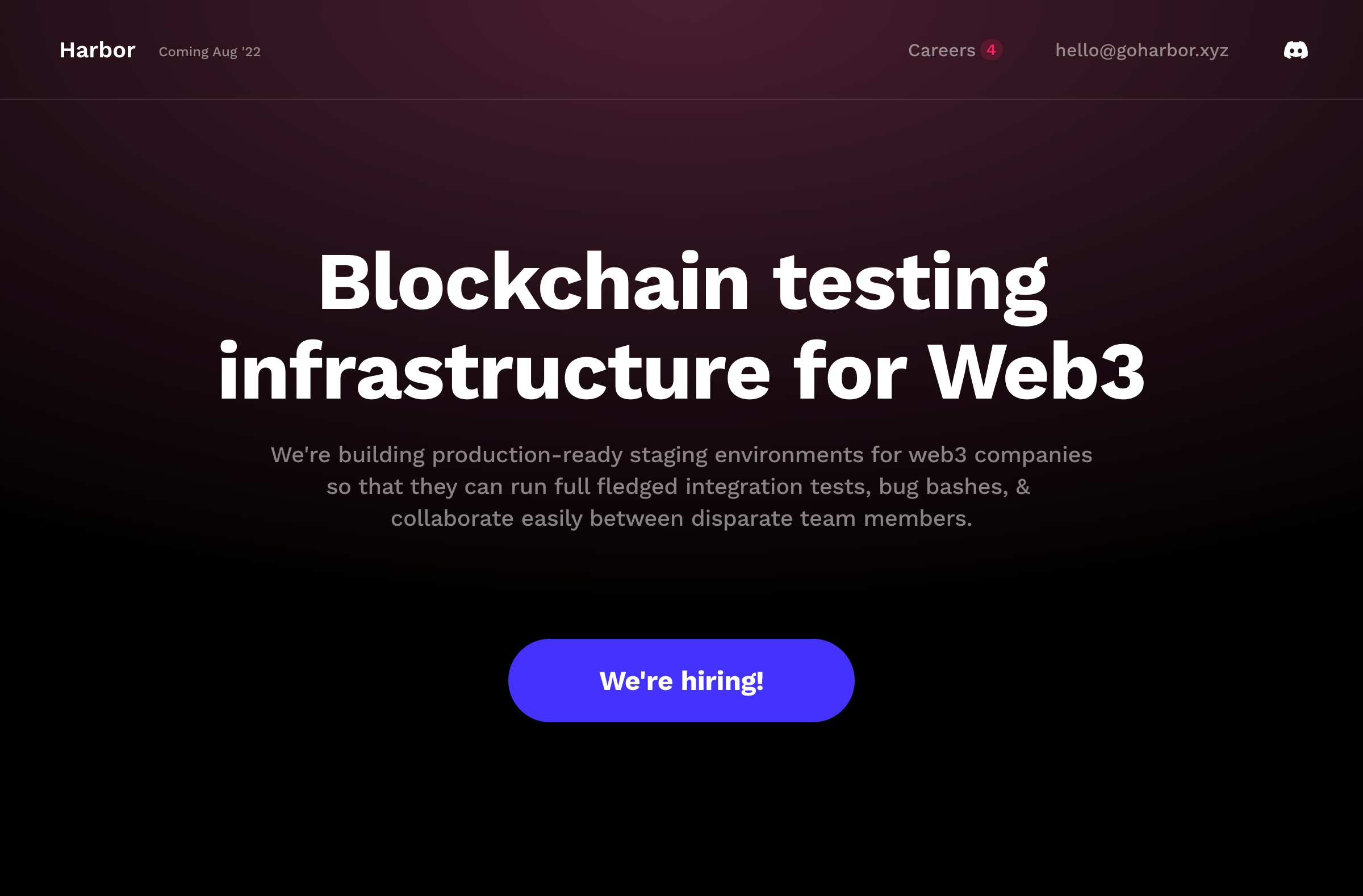 Harbor’s product vision
Harbor’s product vision
Harbor is a testing infrastructure company in the web3 space. The company is aiming to provide production-ready staging environments for web3 companies so they can run full-fledged integration tests, bug bashes and collaborate easily between disparate team members.
Why I’m joining Harbor?
- True 0 → 1 journey - As I mentioned earlier, working with a 0 → 1 product is my first priority and since Harbor doesn’t have a product yet and is just starting to work towards it - it can’t get any more “ground zero” work than this. This is what excites me - to build products in ambiguity. To find solutions to user problems and package it into software that I’m really proud to ship.
- Lean team - From my early talks with both the co-founders, one thing was very clear - that they don’t want to build a company of hundred employees. They want to be very lean, hire generalists who can wear multiple hats in their own domain, and pay them top market salary.
- Leading design - The role was exactly what I was looking for. I wanted to keep leading design for startups and during all my rounds, the founders showed immense trust in me to allow all the space & resources I need to lead design at Harbor.
- Transparency at the core - Both founders seemed very honest in their approach of building the company. They both were open in taking feedback about the interview process. They answered all questions I had about the role, product, company at lengths - without ever getting annoyed. Another thing I liked was that they did the compensation round right after my intro call, so I knew what the company can offer if I clear all the rounds.
- New domain & learning opportunity - Although I understand on a surface level what blockchains are and how they work. I have no idea how blockchain apps are being developed and what are the challenges around it. This new and unknown frontier is what got me super excited to join Harbor.
What’s next?
- New website: Before joining I worked on a basic website using Framer. A lot will change on the landing page as I join and build new features but you can check out the current version on p0.inc
- New product: Since this is ground zero work, we’re working on the MVP as we speak. So look out for more news around the product on our socials. (Twitter & LinkedIn)
- We’re hiring: We’re setting up our engineering team and there are 4 roles open. Have a look at the JD and if the JD fits, consider applying :)
